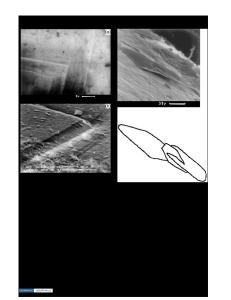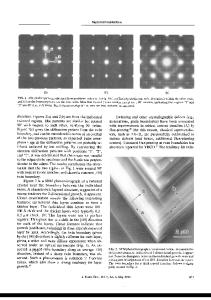Superconductivity and Stoichiometry in Tl 2 Ca 2 Ba 2 Cu 3 O x Single Crystals
- PDF / 317,874 Bytes
- 4 Pages / 420.48 x 639 pts Page_size
- 14 Downloads / 362 Views
SUPERCONDUCTIVITY AND STOICHIOMETRY IN TI 2Ca 2Ba 2CusOx SINGLE CRYSTALS E. L. VENTURINI, C. P. TIGGES, R. J. BAUGHMAN, D. S. GINLEY, AND B. MOROSIN Sandia National Laboratories, Albuquerque, NM 87185-5800 ABSTRACT Magnetization and resistivity data are presented which show a substantial difference in superconducting transitions for nominal Tl 2Ca2Ba 2Cu30 plates with identical crystal structures grown from two different "melt" compositions. A TI-O and CuO-rich flux yielded approximately stoichiometric plates which have sharp transitions beginning near 11 K, while a second TI-O-rich flux produced plates containing more TI and less Ba with very broad transitions starting near 96 K. These data demonstrate the extreme sensitivity of superconductivity to cation site disorder in the TI-Ca-Ba-Cu-O system. INTRODUCTION Substantial experimental and materials processing efforts are focussed on the chemically complex Bi-Sr-Ca-Cu-O [(1 and TI-Ca-Ba-Cu-O [21 systems which include a multitude of superconducting structural phases. Each phase has a significant range of lattice constants and superconducting transition temperatures (T,'s) [3-9]. The TI-Ca-Ba-Cu-O system includes a phase with nominal composition Tl2Ca2Ba 2 Cu3 O, (TI-2223, c axis = 36 A) that shows zero resistance and a Meissner effect up to 125 K as a sintered ceramic [3] or a single crystal [5]. In contrast, Ta's for our "best" single crystals of TI-2223 range from 108 to 115 K [4,8], while others report Tc's from 115 to 120 K [7,9]. Typically, the ceramic Meissner signal has reached 60% of its low temperature value before the transition in the single crystal begins. Since the TI-2223 phase has the highest confirmed T, in the TI-Ca-Ba-Cu-O system, the higher TC in TI-2223 ceramic cannot be attributed to the presence of substantial amounts of a second phase such as TI-1324 [10]. Furthermore, such phases are not observed in amounts detectable by conventional powder X-ray diffraction (XRD). Another possible explanation is that ceramic samples routinely exhibit higher Ta's because cation site inhomogeneity, if any, is controlled by the stoichiometry during synthesis. Hence homogeneity might be retained in small crystallites or grains using preparations with the correct initial composition. In contrast, larger plates might exhibit a continuous cation gradient until the concentrations adjacent to the plate during growth exceed some limit. At this point a different phase or an intergrowth would be initiated. Transitions in YBa 2Cu30 7 d ceramic, thin films and single crystals are reported within 1 K of 92 K for high-quality samples with complete oxygenation. This reproducibility is attributed to the limited atomic substitution. We have previously shown that a significant range of transition temperatures (To's) can be observed for as-grown single crystals with the identical structural phase and nominal composition [4,8]. Differences in the cation ratio (such as TI/Ca disorder) which may be detected by corresponding changes in c-axis length were suggested as contributing f
Data Loading...











